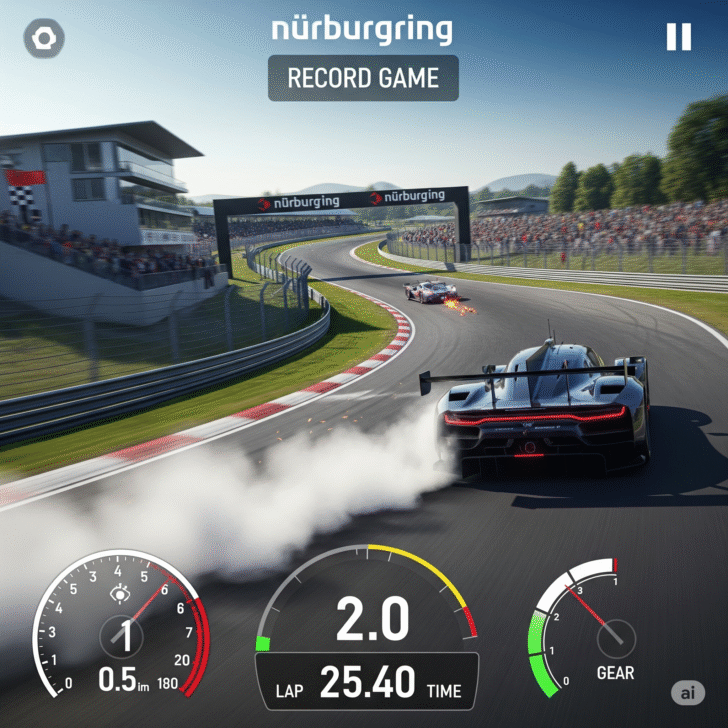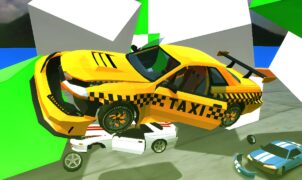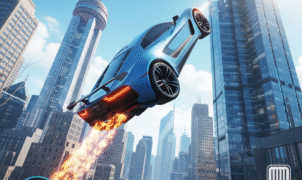Your Nurburgring Record
Your Nurburgring Record
Experience the thrill of mastering Your Nurburgring Record from the very first corner in this comprehensive guide tailored for U.S. gamers. Whether you’re aiming to shave seconds off your lap time, understand the best key bindings, or simply learn how to play Your Nurburgring Record like a pro, this article will walk you through every step. We’ll dive into the essential keyboard controls, game mechanics, setup recommendations, and advanced strategies—all designed to help you conquer the iconic Nürburgring Nordschleife in your virtual cockpit.
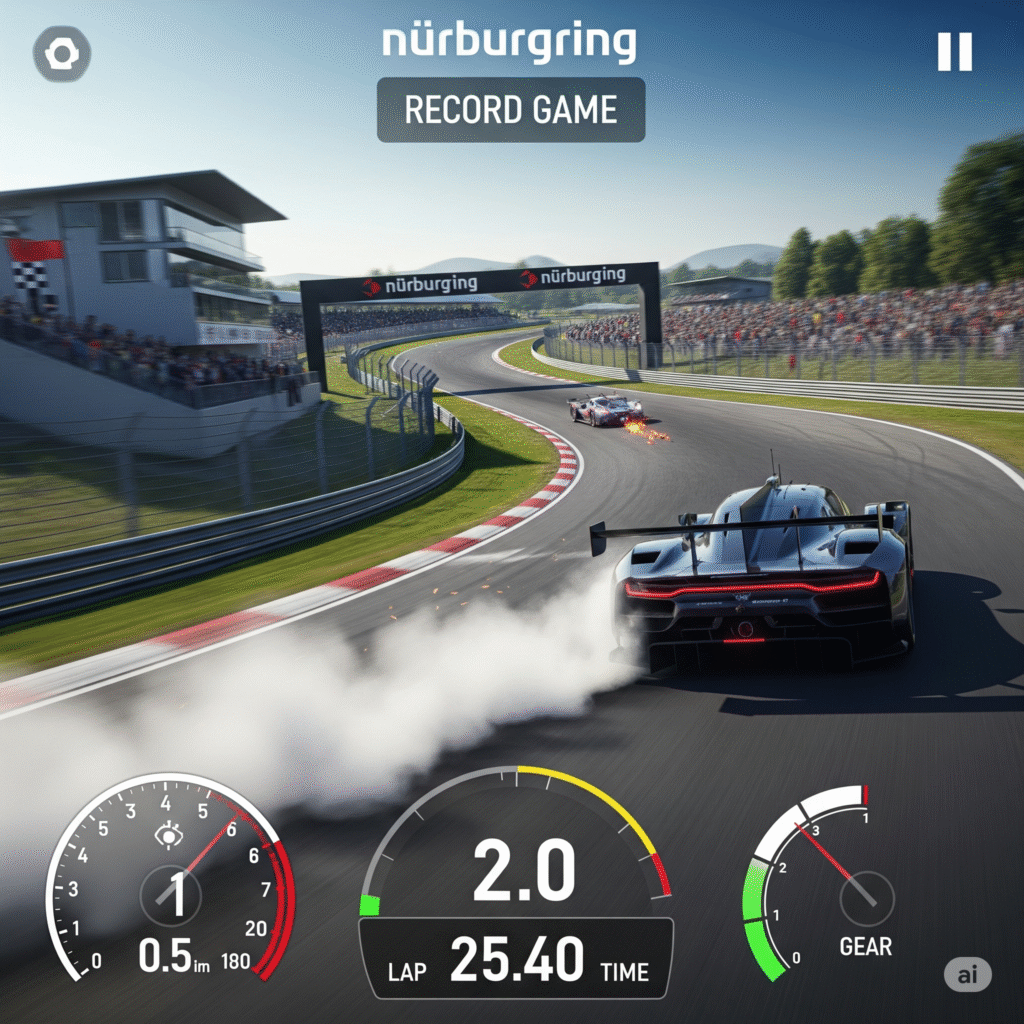
Table of Contents
- What Is “Your Nurburgring Record”?
- System Requirements and Installation
- Essential Keyboard Controls
- Game Modes and Objectives
- Setting Up Your Race Environment
- Beginner Tips for Faster Lap Times
- Intermediate Strategies to Improve Your Time
- Advanced Driving Techniques
- Troubleshooting and FAQs
- Conclusion and Next Steps
<a name=”what-is-your-nurburgring-record”></a>
1. What Is “Your Nurburgring Record”?
“Your Nurburgring Record” is a simulation-focused racing title developed to replicate the Nürburgring Nordschleife in meticulous detail. With realistic car physics, dynamic weather, and a fully rendered 12.9-mile (20.8 km) circuit, this game offers both casual racers and serious sim enthusiasts an opportunity to chase legendary lap times. If you’re new to racing sims, think of this as a virtual time trial where every turn and straight influences your final time. As you push to top the leaderboard, you’ll realize why the Nürburgring is often called “The Green Hell.”
Why It Matters
- Iconic Track: The Nürburgring Nordschleife remains one of the most challenging and revered circuits in motorsport history—learn more about its heritage on the official Nürburgring site.
- Competitive Environment: Compete against global leaderboards or set personal bests in solo time trials.
- Skill Development: Whether you’re using a keyboard, gamepad, or wheel and pedal setup, the game’s physics engine rewards precision and consistency, helping you refine real-world driving skills.
<small>Source: Official Nürburgring History Overview </small>
<a name=”system-requirements-and-installation”></a>
2. System Requirements and Installation
Before diving into tips and controls, ensure your PC meets the recommended specifications. Optimizing performance is crucial for consistent frame rates, which greatly affect input responsiveness.
Minimum Requirements
- OS: Windows 10 (64-bit)
- CPU: Intel Core i5-4590 / AMD Ryzen 3 1200
- RAM: 8 GB
- GPU: NVIDIA GeForce GTX 970 / AMD Radeon RX 580
- Storage: 50 GB available space
Recommended Requirements
- OS: Windows 11 (64-bit)
- CPU: Intel Core i7-9700K / AMD Ryzen 7 3700X
- RAM: 16 GB
- GPU: NVIDIA GeForce RTX 2070 Super / AMD Radeon RX 6700 XT
- Storage: NVMe SSD (for faster loading times)
Installation Steps
- Purchase and Download: The game is available on Steam and other PC marketplaces. For the best deals and community features, consider buying on Steam.
- Install Updates and Patches: After installation, allow the launcher to download the latest patches to ensure you have updated car physics and track data.
- Initial Launch and Settings: Open the game, navigate to Options > Graphics, and select a resolution that matches your monitor’s native setting (e.g., 1920×1080 for most U.S. gamers). Turn on VSync if you experience screen tearing, or adjust frame-rate caps to match your monitor’s refresh rate (e.g., 60 Hz, 144 Hz).
<small>Source: Steam Community Forums </small>
<a name=”essential-keyboard-controls”></a>
3. Essential Keyboard Controls
Using a keyboard might not match the immersion of a wheel and pedal setup, but it’s often the most accessible option for U.S. players just starting. Below are the default key bindings—feel free to remap them for personal comfort under Options > Controls > Keyboard in-game.
| Function | Default Key | Description |
|---|---|---|
| Accelerate | W | Full throttle. Hold down to accelerate. |
| Brake | S | Apply brakes. Press repeatedly for threshold braking. |
| Steer Left | A | Gradually hold down for smooth left turns. |
| Steer Right | D | Gradually hold down for smooth right turns. |
| Clutch | Left Ctrl | Use for manual transmission starts and blipping. |
| Gear Up | E | Shift up one gear. Timing is critical for performance. |
| Gear Down | Q | Shift down one gear. Use when entering corners. |
| Handbrake | Space | Useful for tight hairpins; avoid overuse. |
| Look Left | Left Arrow | Change camera angle to view apex or exit. |
| Look Right | Right Arrow | Adjust camera to view upcoming corner. |
| Pause/Menu | Esc | Access game menu, settings, and quit options. |
| Reset Car (Off-Track) | R | Instantly respawn on track—use during practice. |
| Fuel Map Up/Down | Page Up / Page Down | Adjust fuel map settings mid-race (affects performance vs. economy). |
Pro Tip: If you plan to graduate from keyboard to a gamepad or wheel later, keep these keys in mind for a smooth transition—most controllers will have analogous button assignments.
<a name=”game-modes-and-objectives”></a>
4. Game Modes and Objectives
Understanding the various game modes is critical to mastering Your Nurburgring Record. Each mode offers different objectives, from casual laps to intense leaderboard battles.
4.1 Time Trial Mode
- Objective: Complete a single lap as quickly as possible.
- Leaderboard: Compare your time against global U.S. players or friends.
- Best Practices:
- Use shorter practice sessions to learn key sections (e.g., Hatzenbach, Karussell).
- Toggle the Ghost Car feature to race against your previous best lap.
4.2 Career Mode
- Objective: Progress through a series of challenges, earning currency to purchase and upgrade cars.
- Structure:
- Novice Challenges – Short track sessions with entry-level cars.
- Intermediate Tiers – Unlock faster GT cars; face tougher AI competition.
- Expert Races – Full-length Nordschleife events with real-world track conditions, including weather changes.
- Tip: Allocate in-game earnings to upgrade tires and suspension early on for better lap consistency.
4.3 Multiplayer Mode
- Objective: Race against up to 16 online opponents.
- Key Modes:
- Public Races: Join live sessions.
- Private Lobbies: Invite friends or create a dedicated time-trial tournament.
- Internet Latency: For U.S. players, connecting to servers in North America (e.g., East Coast) typically yields lower ping. Always perform a Network Test under Options > Online before entering a lobby.
4.4 Time Attack Weekly Events
- Objective: Every week, developers release new seasonal events with special rules (e.g., limited car classes, fixed weather conditions).
- Benefits:
- Unique rewards such as exclusive liveries, decals, and in-game currency.
- Opportunity to benchmark your performance against top-tier U.S. sim racers.
- External Link: Stay updated with upcoming events on the official community calendar: Nürburgring Events.
<a name=”setting-up-your-race-environment”></a>
5. Setting Up Your Race Environment
Whether you’re using a simple keyboard setup or a more elaborate wheel-and-pedal rig, optimizing your environment will directly impact lap times and overall comfort.
5.1 Keyboard and Gamepad Setup
- Keyboard Surface: Place on a flat, non-slip surface (e.g., a desk mat) to prevent movement during intense braking.
- Wrist Support: Consider a gel wrist rest to reduce fatigue during longer sessions.
- Gamepad Option: If you have an Xbox or PlayStation controller, map steering to the left stick, acceleration and braking to the triggers, and gear shifts to the bumpers for improved ergonomics. Many U.S. gamers prefer the Xbox One controller for its PC compatibility.
5.2 Steering Wheel and Pedal Configuration
- Recommended Wheels:
- Entry-Level: Logitech G920 (Forza branding, PC compatible).
- Mid-Range: Thrustmaster T300 RS GT Edition.
- High-End: Fanatec CSL Elite or Logitech G923 TrueForce (features force feedback for enhanced realism).
- Pedal Setup: Ensure pedals are bolted or clamped to a stable base to prevent sliding.
- Calibration Steps:
- Navigate to Options > Controls > Calibration.
- Follow the on-screen prompts to set neutral steering position, maximum steering lock, and full pedal range.
- Test dead zones—most wheels come with software to adjust dead zone removal for more precise inputs.
5.3 Audio and Visual Settings
- Headphones vs. Speakers: U.S.-based gamers often prefer high-quality gaming headsets (e.g., SteelSeries Arctis 7, HyperX Cloud II) to detect engine notes and tire screeches that indicate grip levels.
- Monitor and Refresh Rate:
- For keyboard users: A standard 60 Hz monitor suffices.
- For wheel enthusiasts: Consider a 144 Hz monitor or ultrawide display (e.g., 3440×1440) to maximize field of view.
- Graphics Tweaks:
- Shadows and Reflections: Lower these for more consistent FPS during rain or sunset sessions.
- Anti-Aliasing: Use TAA or FXAA to smooth edges without too much performance hit.
- Motion Blur: Turn off to better judge braking points visually.
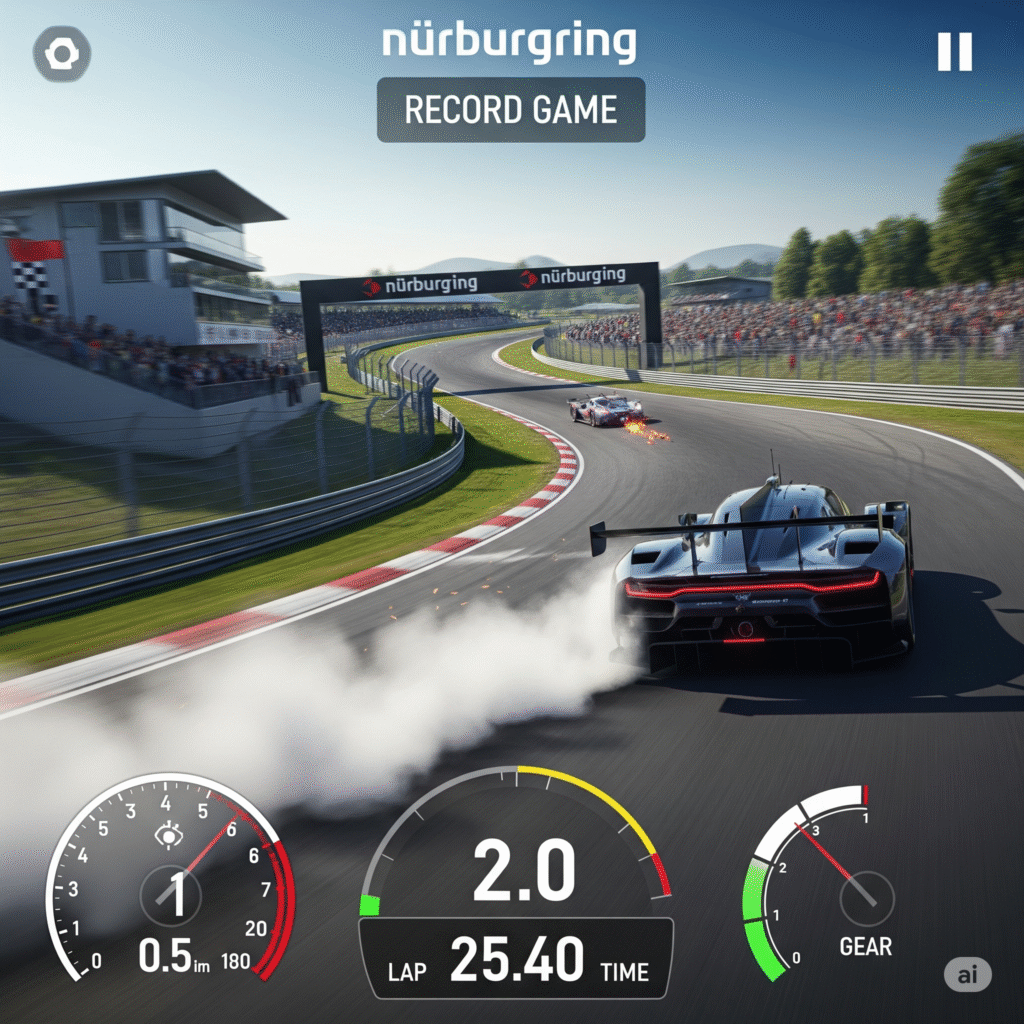
<a name=”beginner-tips-for-faster-lap-times”></a>
6. Beginner Tips for Faster Lap Times
As you fire up Your Nurburgring Record, keep these foundational strategies in mind. By focusing on consistency and understanding track flow, you’ll start lowering your times quickly.
6.1 Learning the Track Layout
- Split the Nordschleife into Sectors:
- Sector 1 (Green Hell Start to Adenauer Forst): Emphasize smooth throttle control through the Hatzenbach section.
- Sector 2 (Adenauer Forst to Flugplatz): Focus on maintaining momentum over downhill crests.
- Sector 3 (Flugplatz to Kesselchen): Prioritize proper braking zones before tight corners like Aremberg.
- Use the In-Game Track Map: Activate the mini-map (press M by default) to anticipate upcoming corners and straight lengths.
6.2 Throttle and Braking Control
- Feather the Throttle: On exit of slow corners (e.g., Fuchsröhre), ease onto the throttle to avoid oversteer.
- Early Braking: Approach braking zones with incremental pedal application; avoid sudden “stabbing” of the brake key or button.
- Trail Braking: As you gain confidence, practice trail braking into medium-speed corners—this technique reduces understeer and improves turn-in.
6.3 Apex and Line Optimization
- Visualize Apex Points: Most Nürburgring corners have a reference point—trees, kerbs, or track-side signage. Use them to hit consistent apexes.
- Straight-Line Entry: Before braking, straighten the steering as much as possible. This maximizes tire grip when decelerating.
- Exit Line: Open the wheel early on corner exit to get back on the throttle sooner.
6.4 Gear Selection and Engine Braking
- Manual vs. Automatic: Even if you use automatic shifting initially, switch to manual (press M in-game) to gain direct control over engine braking and gear selection.
- Downshifting Strategy: Downshift one gear at a time (press Q for each downshift) just before heavy braking zones to help slow the car.
6.5 Practice Makes Perfect
- Ghost Car: Always enable the ghost car to compare your current lap to your best.
- Segment Focus: Instead of running full laps, do repeated runs through challenging segments—this isolates problem areas (e.g., Pflanzgarten I-II).
- Record Replays: After completing laps, review replays (press F2). Look for braking inconsistencies or missed apexes.
<small>Source: Racing Techniques Basics </small>
<a name=”intermediate-strategies-to-improve-your-time”></a>
7. Intermediate Strategies to Improve Your Time
After you’ve established a consistent baseline, it’s time to adopt intermediate tactics that refine your driving and setup approach.
7.1 Vehicle Selection and Tuning
- Car Classes: The game features multiple classes—Touring Cars (Class A), GT3 (Class B), Supercars (Class C), and Hypercars (Class D).
- Touring Cars (Class A): Easier to handle for intermediate drivers; lower downforce but less power.
- GT3 (Class B): Balanced performance; begin here before stepping up to Supercars.
- Supercars (Class C) & Hypercars (Class D): High power demands advanced throttle control.
- Suspension Settings:
- Camber: Slight negative camber (–1.0° to –2.0°) helps cornering grip.
- Toe: Neutral or slight toe-in for stability on straights.
- Ride Height: Lower ride height for improved aerodynamics but watch for bottoming out in sections like Pflanzgarten.
- Brake Bias: Adjust towards rear (e.g., 56% front to 44% rear) if you’re experiencing heavy understeer into corners; shift forward if the car oversteers under braking.
7.2 Weather and Track Conditions
- Dynamic Weather Impact: Rain adds a layer of complexity—wet grip is significantly reduced, making braking points earlier and corner speeds lower.
- Tire Choices:
- Normal Tires: Adequate for dry conditions; good durability.
- Soft Compound: Improved grip for qualifying-style runs but lower lifespan—ideal for time attack sessions where tire wear is minimal.
- Wet Tires: Mandatory for full wet conditions; they channel water away but degrade quickly if track begins to dry.
- Track Temperature: Higher temps (above 80°F/27°C) reduce grip; adjust tire pressures accordingly (0.3–0.5 psi higher to maintain ideal contact patch).
7.3 In-Game Telemetry
- Activating Telemetry: Go to Options > HUD > Telemetry Data. Enable live graphs for speed, braking force, and steering angle.
- Interpreting Data:
- Brake Pressure Graph: Look for smooth peaks rather than jagged spikes—this indicates controlled braking.
- Throttle Application: Monitor for gradual throttle application, especially exiting corners like Hohe Acht.
- Steering Angle: Avoid sudden jerks; consistent input yields faster cornering speeds.
7.4 Comparing Against Benchmarks
- Ghost Comparison: Toggle between your car and the “Fastest Lap” ghost in time trial mode. Watch for differences in braking points by toggling camera to chase view.
- Community Setups: Many U.S. players share setup files on community forums like RaceDepartment. Test these setups to understand baseline values, then personalize for your driving style.
- Video Analysis: Record your play sessions using software like OBS Studio (free download). Upload to YouTube and tag relevant keywords, e.g., “Nürburgring time trial,” to solicit feedback from fellow sim racers.
<small>Source: RaceDepartment Setup Library </small>
<a name=”advanced-driving-techniques”></a>
8. Advanced Driving Techniques
Now that you’ve honed your intermediate skills, it’s time to delve into advanced maneuvers that can turn lap seconds into lifetimes.
8.1 Optimizing Tire Warm-Up
- Warm-Up Lap: Before a hot lap, do two cool-down and warm-up laps to bring tires to optimal temperature (180°F–200°F).
- Brake Dabbing: Lightly tap the brakes mid-corner exit to create friction and heat. This ensures the tires are sticky when you start the timed lap.
- Monitoring Tire Data: If your wheel or controller supports in-game tire temperature display, aim for even temperature distribution across the tire (±5°F).
8.2 Sacrificing Time for Corner Speed
- Corner Entry vs. Exit Trade-Off: For some corners, it’s faster to brake slightly earlier and carry more speed through the mid-corner, even if it costs a bit on exit. For example, in the Schwalbenschwanz, maintain a tighter line through the middle rather than aiming for maximum entry speed.
- Reverse Nurburgring Line: On extremely long straights (e.g., from Flugplatz to Schwedenkreuz), use banking to keep throttle on longer—learn to trust slight curb riding to maintain momentum.
8.3 Using Engine Braking Effectively
- Left-Foot Braking (Keyboard Equivalent): Though challenging on a keyboard, try alternating between the S key (brake) and easing off throttle for mild engine braking. On a wheel, use the clutch or engine braking settings in the car setup.
- Heel-Toe Downshifting: Essential in tight corners like Karussell. If you have a compatible pedal set, practice blipping the throttle with your heel to match revs during downshifts, preventing rear lock-up.
8.4 Capitalizing on Slipstream
- Drafting on Straights: Follow another car closely (within 1–2 car lengths) on long straights to reduce air resistance. Then, slip past on the outside when the opportunity arises—often the difference between cutting 0.1–0.2 seconds on a segment.
- Out-Braking in Turns: After drafting, position yourself slightly to the inside before a braking zone, forcing the car ahead wide and allowing for a tighter apex.
8.5 Adapting to Real-World Racing Line Data
- Official On-Board Footage: Study real-world on-board videos from Nürburgring 24H races. Notice where professional drivers lift mid-straight, or brake tricks they use.
- Replay Overlays: Some tools (e.g., Atlas Tire) allow overlaying real lap data onto your in-game telemetry—examine where your line deviates by even half a car width.
8.6 Mental Approach and Consistency
- Visualization Techniques: Before each lap, mentally walk through every turn, visualizing braking points and gear changes.
- Breathing Control: Implement deep-breathing exercises between runs to keep adrenaline in check. A steady heart rate leads to smoother inputs.
- Session Length: Cap practice sessions at 45 minutes to prevent burnout—fatigue often leads to small mistakes that can add up laps later.
<small>Source: Nürburgring 24H On-Board Archives </small>
<a name=”troubleshooting-and-faqs”></a>
9. Troubleshooting and FAQs
Below are common issues U.S. players encounter, along with expert solutions to keep you on track.
9.1 Input Lag and Controller Calibration
- Issue: Steering feels delayed when using a wheel or gamepad.
- Solution:
- In Options > Controls, reduce the input buffer size.
- For wheel users, update firmware via the manufacturer’s software (e.g., Logitech G HUB).
- If using a wireless controller, switch to a wired USB connection to minimize latency.
9.2 Low Frame Rate during Heavy Weather
- Issue: FPS drops significantly when it starts raining or during sunset.
- Solution:
- Lower Shadow Quality to medium or low.
- Disable Motion Blur and Depth of Field under Graphics Settings.
- Use DLSS (NVIDIA GPUs) or FidelityFX Super Resolution (FSR) to upscale from a lower render resolution while maintaining visual clarity.
9.3 Brake Lock-Ups on Corner Entry
- Issue: The car’s wheels lock under heavy braking, causing a loss of control.
- Solution:
- Adjust Brake Bias toward the rear (e.g., 54% front / 46% rear) under Garage > Setup.
- Modulate the brake key—tap lightly before gradually increasing to avoid sudden lock-ups.
- Enable ABS Light in the HUD to see when ABS engages; if ABS is constantly on, reduce brake pressure input.
9.4 Unable to Improve Past Certain Lap Time
- Issue: You’ve plateaued and can’t shave off additional tenths of a second.
- Solution:
- Revisit telemetry to identify consistent slow segments.
- Switch to a lower tire pressure (–0.2 psi) for increased mechanical grip in slow corners.
- Compare ghost data: Are you losing time consistently at specific corners? Focus practice there.
9.5 Game Crashes or Doesn’t Launch
- Issue: The game crashes to desktop on startup.
- Solution:
- Verify integrity of game files via Steam (Right-click game > Properties > Local Files > Verify Integrity).
- Update GPU drivers (NVIDIA GeForce Experience or AMD Radeon Software).
- Run the game as Administrator, and ensure Windows firewall or antivirus isn’t blocking executables.
<a name=”conclusion-and-next-steps”></a>
10. Conclusion and Next Steps
By following this guide, you now have the knowledge to tackle Your Nurburgring Record, from mastering essential key bindings (W, A, S, D, Q, E, etc.) to applying advanced tire strategies and mental techniques. Remember that consistency, incremental improvements, and studying both in-game telemetry and real-world footage are the pillars of success on the Nürburgring Nordschleife.
Key Takeaways
- Practice Sector by Sector: Break the 12.9-mile circuit into manageable chunks to identify tricky sections.
- Optimize Your Setup: Whether using a keyboard or a high-end wheel, ensure controls are calibrated and ergonomics are comfortable for long sessions.
- Use Telemetry: Analyze data to spot braking, throttle, or line inconsistencies—small adjustments can yield significant time gains.
- Focus on Tire Management: Proper tire warm-up, compound selection, and pressure adjustments can be the difference between a good lap and a great one.
- Mental Preparedness: Employ breathing and visualization techniques to maintain calm and focus during high-pressure time trial runs.
Where to Go Next
- Internal Resource: For more in-depth car setup tutorials, check out our Advanced Racing Setups Guide.
- Internal Resource: Learn how to transition from keyboard to wheel with our Wheel & Pedal Installation Tutorial.
- External Resource: Explore detailed driving lines and racing schools at the Nürburgring’s official website: TourGuidance Nürburgring.
Feel free to revisit sections of this guide as you progress—each lap at the Nürburgring Nordschleife presents unique challenges and learning opportunities. With dedication and the right approach, you’ll see your lap times drop, and you’ll soon have bragging rights among friends with a new Your Nurburgring Record.
Happy racing, and may your tires stay warm!
Disclaimer: This guide is intended for informational purposes. Actual game controls, settings, and performance may vary based on hardware configurations and official game updates. Always refer to the latest in-game menus and patch notes for changes.
Author’s Note: If you found this guide helpful, consider sharing it with fellow sim racers on social media, and check out additional content to refine your skills.


